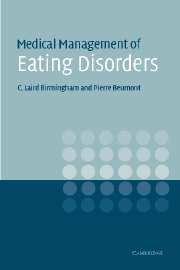Book contents
- Frontmatter
- Contents
- List of color plates
- List of contributors
- List of abbreviations
- Introduction
- PART I THE MEDICAL PERSPECTIVE
- PART II TREATMENT
- 6 Principles of treatment
- 7 Medical and nutritional therapy
- PART III SPECIAL ISSUES
- PART IV THE PSYCHIATRIC AND PSYCHOLOGICAL PERSPECTIVE
- PART V AREAS OF SPECIAL INTEREST
- Bibliography
- Index
- Plate section
6 - Principles of treatment
Published online by Cambridge University Press: 18 December 2009
- Frontmatter
- Contents
- List of color plates
- List of contributors
- List of abbreviations
- Introduction
- PART I THE MEDICAL PERSPECTIVE
- PART II TREATMENT
- 6 Principles of treatment
- 7 Medical and nutritional therapy
- PART III SPECIAL ISSUES
- PART IV THE PSYCHIATRIC AND PSYCHOLOGICAL PERSPECTIVE
- PART V AREAS OF SPECIAL INTEREST
- Bibliography
- Index
- Plate section
Summary
General principles of treatment
Eating disorders, like several other severe psychiatric illnesses, are seldom simply “cured”. Relapses and a need for further treatment are common. Continued care and ongoing treatments that are lengthy and expensive are usually necessary for those with more chronic illness.
The eating disorder patient has the same right to treatment as patients with any other illness. They should not be denied this simply because their illness can be considered as “self-inflicted”. Our society accepts that most illnesses are self-inflicted to some or other extent: malignant melanoma results from incautious exposure to the sun; cardiovascular disease is commonly associated with overindulgence in food; emphysema, lung cancer, and other neoplasias result from cigarette smoking; and HIV and AIDS are associated with unsafe sexual behavior and the use of contaminated needles. Where the eating disorder patient differs perhaps from the others is that the risk-taking behavior persists throughout the illness: if only the patient would change their behavior, then they would recover. However, it is not that simple. Once embarked on a course of illness, it is difficult to abandon it, particularly in the case of AN. There is something about the nature of being anorexic that is resistant to change. What makes anorexic behavior so persistent? That still needs explanation. Just as it was necessary to realize that nicotine is an extremely addictive drug before effective measures could be developed to help people give up cigarette smoking, so it will be necessary to understand what hold the eating disorder has on the patient before we can help them to recover from it.
- Type
- Chapter
- Information
- Medical Management of Eating DisordersA Practical Handbook for Healthcare Professionals, pp. 115 - 127Publisher: Cambridge University PressPrint publication year: 2004

